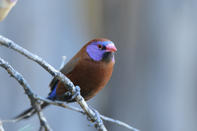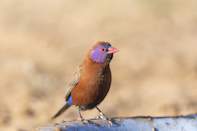
Name
Violet-eared waxbill (Granatina granatina)
Violet-eared Waxbill Appearance
The violet-eared waxbill is one of the most colourful seed eaters found in South Africa. This waxbill has violet cheeks, a red bill and a blue forehead and rump. The body has chestnut plumage. A dark eye, with a red eye ring present.
The female violet-eared waxbill has the same colouring as the male, but the colours are paler and the chest is fawn in colour.
This is a small bird at around 14 cm in length.
Violet-eared Waxbill Diet
The violet-eared waxbill feeds mostly on seeds, but will eat nectar and insects.
Violet-eared Waxbill Breeding
The violet-eared waxbill is monogamous. The nest is a ball-shaped grass structure, normally around 2 m off the ground in a shrub or tree. The female lays between four and five eggs, that hatch around 12 days later. This waxbill is parasitized by the Shaft-tailed Whydah (Vidua regia).
Violet-eared Waxbill Behaviour

The violet-eared waxbill is found in pairs or small family groups. This waxbill is often seen with blue waxbills (Uraeginthus angolensis) and can be seen foraging in the deep shadows under bushes.
Threats
None.
Where to Find Violet-eared Waxbill
The violet-eared waxbill main habitat is acacia thickets or forests, in semi-arid to arid savanna. This waxbill can be found in the central and northern areas of South Africa.
A stay in Marakele National Park will offer birders a good chance of seeing the Violet-eared Waxbill.
 The Marakele National Park covers the most impressive section of the Waterberg range, rolling out across the bushveld to the north....
The Marakele National Park covers the most impressive section of the Waterberg range, rolling out across the bushveld to the north....